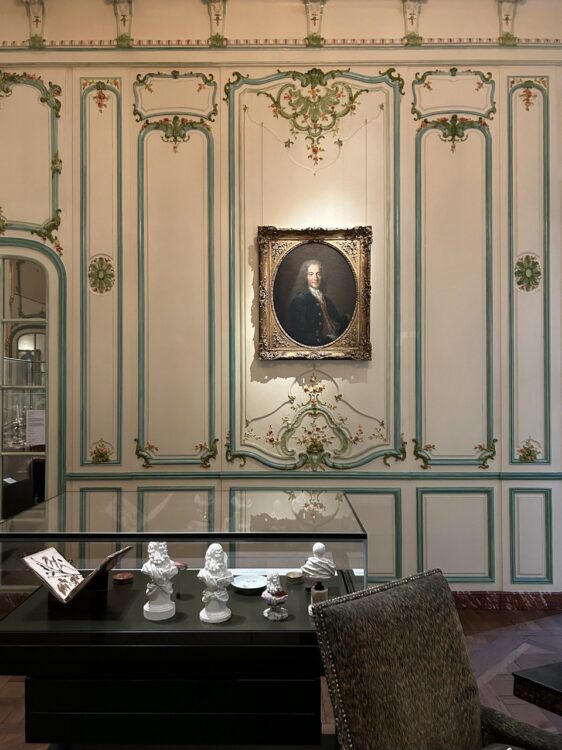What Makes an Image Iconic?
15 Oct 2025|Sofya Dmitrieva
- Research

As a Junior Research Fellow at St Edmund Hall, I am assisting the Voltaire Foundation in creating a comprehensive database of Voltaire’s portraits and writing a book on his iconography.
Iconography refers to the system of visual codes that define how a person, subject, event, or idea is represented.
Rather than viewing iconography as a sum of its elements (motifs, themes, and attributes), it is more productive to think of it as a kind of a world, governed by its own internal logic. Based on the images we have seen and our broader perception of the subject, we come to expect certain things and not others. The AI-generated image of the Pope in a voluminous white puffer jacket feels comic and uncanny not simply because it introduces a new element into his visual world, but because this element violates its very foundations (moral, emotional, ideological, as well as aesthetic). Contemporary celebrities play with such expectations, and with our growing appetite for novelty, by inventing new “eras”, often completely reimagining themselves and thereby expanding the limits of the expected.
Within any given iconography certain elements carry more weight than others. We would not expect Buster Keaton to smile — that would be in direct contradiction to his carefully crafted, universally recognised persona. Whereas in the case of Voltaire, quite the contrary, the absence of a smile was often taken as a failure of resemblance. And it was not just any smile that was expected, but a very particular one – a slight, ironic half-grin, detached, knowing, and faintly mocking.
Memorable images generate memorable attributes, which take on lives of their own and can stand in for the person they are associated with. Charlie Chaplin is unimaginable without his moustache, oversized trousers, suspenders, and bowler hat – just as those objects are unimaginable without him. The bowler hat evokes Chaplin, heavy eyeliner Amy Winehouse, and the large, sturdy armchair Voltaire. In fact, the armchair itself became “Voltairean”.
An iconic image is difficult to construct and requires a set of skills distinct from technical mastery. Voltaire was portrayed by some of the finest artists of his time, such as Nicolas de Largillière, Jean-Baptiste Lemoyne, and Jean-Baptiste Pigalle. While their works displayed great skill, and in the case of Pigalle’s Voltaire nu (Fig. 1), even innovation, none became influential prototypes. In this respect, Largillière, Lemoyne, and Pigalle were outdone by the Genevan autodidact Jean Huber – Voltaire’s most prolific and, ultimately, most widely reproduced portraitist. A minor artist by comparison, Huber may not have been capable of a masterpiece, but he understood much better than his celebrated contemporaries what makes an image viral (Fig. 2).
Unlike today (when images are so easily found online), in the eighteenth century, iconography was a matter of access. How could one depict Voltaire, who spent much of his life in exile, far from centres of artistic production? While some artists travelled to his residence in Ferney to portray him from life, most had to rely on existing representations. Paradoxically, in this context, cheap, mass-produced prints held greater iconographic significance than painting or sculpture – singular media we generally value more.
An iconic image is invasive. It is reproduced so widely that it loses the connection to its referent. How many people wearing Che Guevara t-shirts know the particulars of the Cuban Revolution? How many dressed as Holly Golightly for Halloween have actually seen Breakfast at Tiffany’s? By the early nineteenth century, bourgeois families displaying Voltaire’s bust or complete works in their libraries often could not name his most important titles.
Iconography, then, also raises the question of agency: does the star shape the image, or does the image shape the star? We often ask this of Marilyn Monroe, but it applies equally to Voltaire. On one hand, Voltaire carefully managed his public persona, cultivating the image of a perpetually ill, dying (he would live to eighty-three) exile – a persona the public eagerly adopted, as evidenced by prints like Le Vieux Malade de Ferney (“The Old Ill Man of Ferney”). On the other hand, Voltaire was deeply unsettled by popular caricatures of himself, such as Le Déjeuner de Ferney (Fig. 3), and even wrote to the artist, Dominique Vivant-Denon, pleading, “Do not to let this print circulate in public”.
I would like to thank the Leverhulme Trust, St Edmund Hall, and the Voltaire Foundation for their generous support of my research.
Category: Research
Author

Sofya
Dmitrieva
Dr Sofya Dmitrieva is a non-stipendiary Junior Research Fellow in European Languages at St Edmund Hall. Sofya is a historian of art and visual culture, specialising in eighteenth-century France. Her research interests span genre theory, perception studies, and the history of collections.